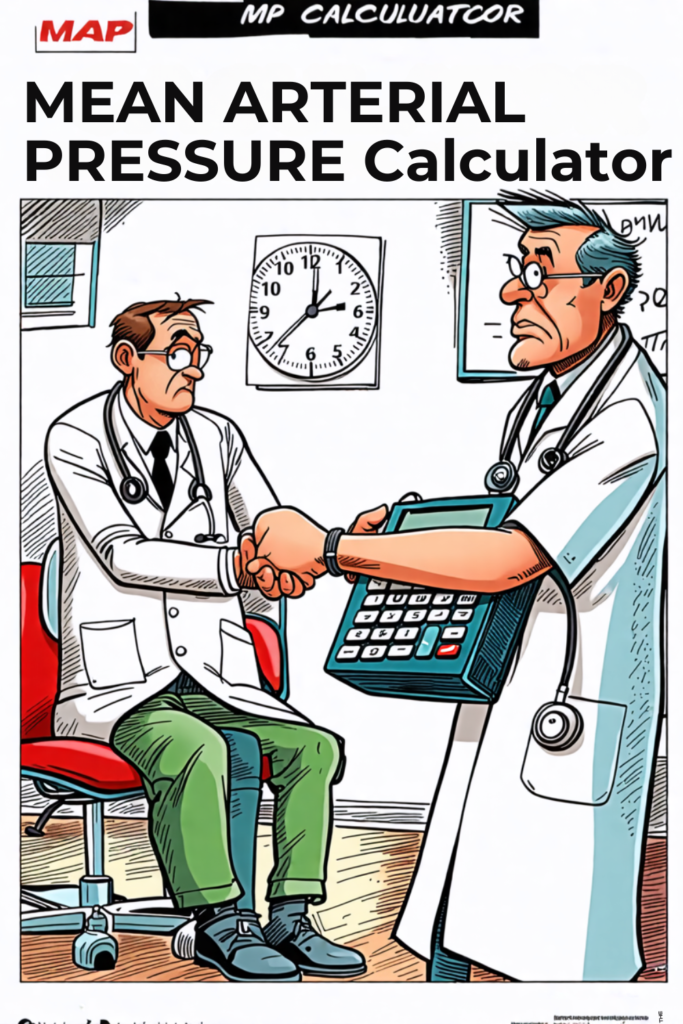MAP Calculator (Mean Arterial Pressure)
The MAP calculator helps you calculate your mean arterial and pulse pressure and warn you if anything is wrong.
Enter your systolic and diastolic blood pressure to determine the mean arterial blood pressure.
In case you don’t know, the average arterial pressure during one cardiac cycle, systole, and diastole, is mean arterial pressure (MAP).
MAP is calculated from systolic and diastolic blood pressure.
The normal MAP range is 70 -100 mmHg.
Long-term mean arterial pressure deviations can have serious health consequences.

You might be interested in finding your patient’s coma scale or sodium ratio in your body.
What is Mean Arterial Pressure (MAP)?
Mean arterial pressure represents the average pressure in a patient’s arteries during one cardiac cycle. It takes into account both the systolic and diastolic blood pressure readings. MAP is an essential indicator of organ perfusion, particularly for vital organs like the brain, heart, and kidneys.
The Importance of MAP in Clinical Settings
Healthcare professionals use MAP to:
- Assess overall cardiovascular health
- Monitor patients in critical care units
- Guide treatment decisions in cases of shock or hypertension
- Evaluate the effectiveness of blood pressure medications
Understanding MAP can provide valuable insights into a patient’s condition, especially in emergency medical situations.
How to Calculate MAP
The MAP calculator uses a standard equation to determine the mean arterial pressure:
MAP = (1/3 × Systolic BP) + (2/3 × Diastolic BP)
This formula takes into account that diastole typically lasts about twice as long as systole during each cardiac cycle.
Using the MAP Calculator
Our MAP calculator is designed to be user-friendly and efficient. Here’s how to use it:
- Enter the systolic blood pressure in mmHg
- Enter the diastolic blood pressure in mmHg
- Click the “Calculate” button
- The result will display the calculated MAP value
The calculator automatically applies the MAP equation, saving you time and ensuring accurate results.
Interpreting MAP Results
While individual cases may vary, here are some general guidelines for interpreting MAP values:
- Normal MAP: 70-100 mmHg
- Low MAP (potential shock): < 65 mmHg
- High MAP (potential hypertension): > 100 mmHg
It’s important to note that these are general ranges, and a healthcare professional should always be consulted for proper interpretation and diagnosis.
MAP in Special Cases
Pediatric Patients
MAP calculation and interpretation may differ for pediatric patients. The normal range for MAP in children varies by age and should be assessed by a pediatric healthcare provider.
Sepsis and Septic Shock
In cases of sepsis or septic shock, maintaining an adequate MAP is crucial. Current guidelines suggest targeting a MAP of at least 65 mmHg in septic shock patients.
Hypertension Management
For patients with hypertension, monitoring MAP can help evaluate the effectiveness of treatment and guide medication adjustments.
Limitations of MAP
While MAP is a valuable tool, it’s important to understand its limitations:
- It doesn’t provide information about pulse pressure
- It may not accurately reflect organ perfusion in all cases
- It should be used in conjunction with other clinical assessments
Healthcare providers consider MAP alongside other vital signs and clinical indicators for a comprehensive patient evaluation.
Frequently Asked Questions about MAP
How often should MAP be measured?
The frequency of MAP measurements depends on the clinical situation. In critical care settings, it may be monitored continuously. For routine check-ups, it’s typically measured along with regular blood pressure readings.
Can I use home blood pressure monitors to calculate MAP?
While home blood pressure monitors provide systolic and diastolic readings, most don’t calculate MAP automatically. You can use our online calculator with your home readings to determine MAP.
Is MAP more important than systolic and diastolic blood pressure?
MAP provides different information than individual systolic and diastolic readings. All three measurements are important and provide valuable insights into cardiovascular health.
How does MAP relate to organ perfusion?
MAP is a key indicator of organ perfusion, particularly for the brain, heart, and kidneys. These organs require a certain level of blood pressure for adequate blood flow and oxygen delivery.

References
- DeMers, D., & Wachs, D. (2021). Physiology, mean arterial pressure. In StatPearls [Internet]. StatPearls Publishing.
- Sesso, H. D., Stampfer, M. J., Rosner, B., Hennekens, C. H., Gaziano, J. M., Manson, J. E., & Glynn, R. J. (2000). Systolic and diastolic blood pressure, pulse pressure, and mean arterial pressure as predictors of cardiovascular disease risk in men. Hypertension, 36(5), 801-807.
- Meaney, E., Alva, F., Moguel, R., Meaney, A., ALVA, J., & WEBEL, R. (2000). Formula and nomogram for the sphygmomanometric calculation of the mean arterial pressure. Heart, 84(1), 64-64.





